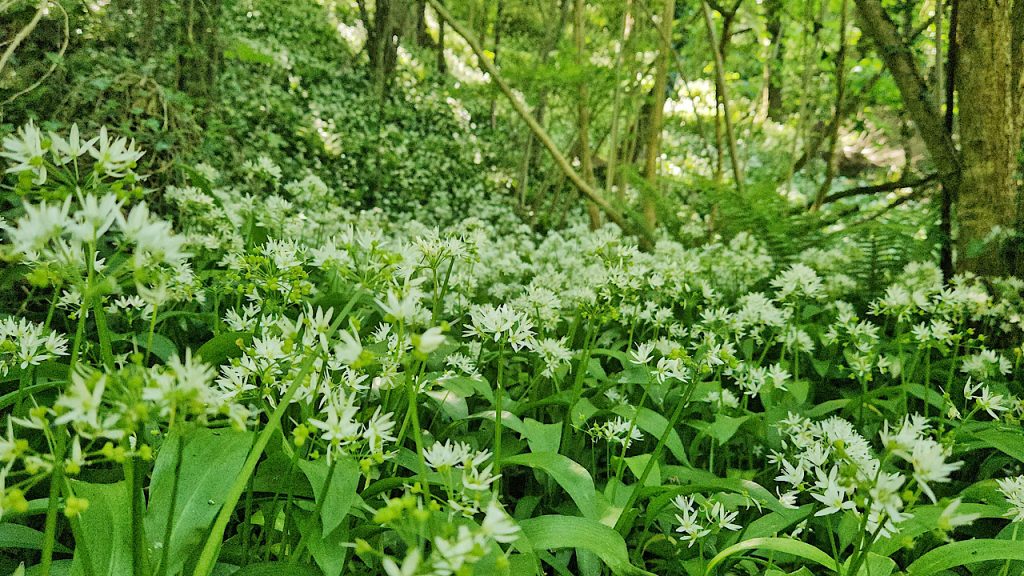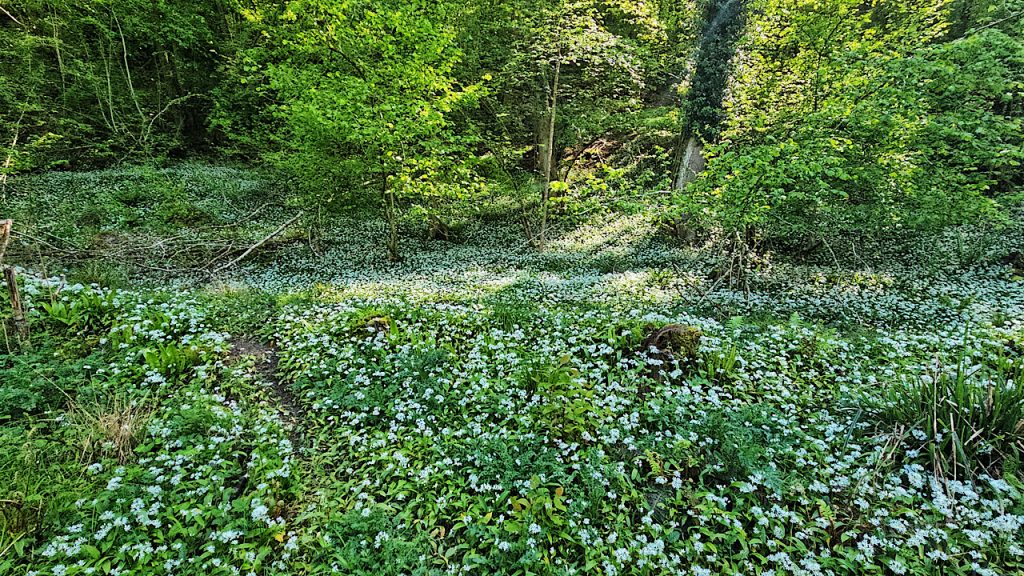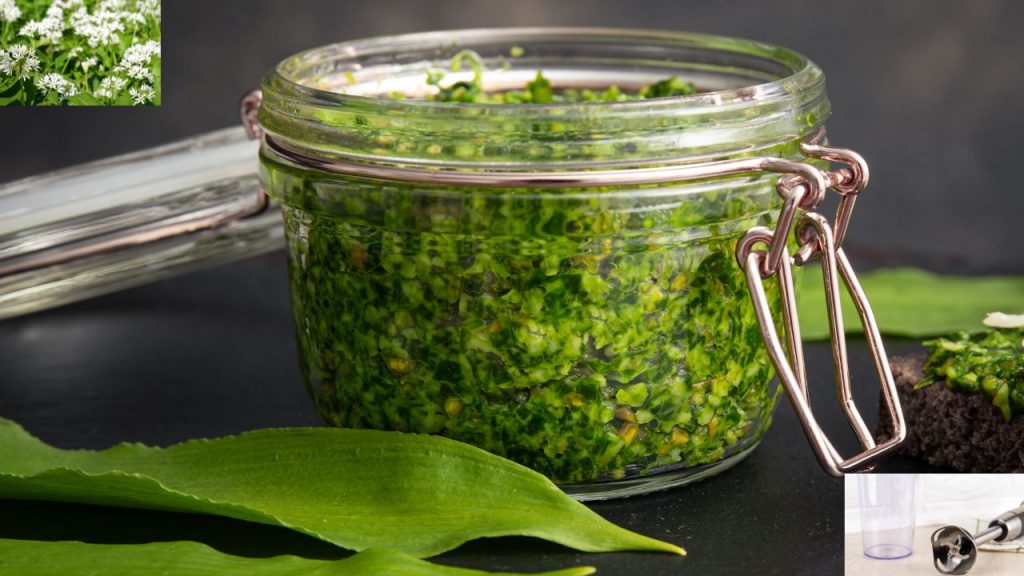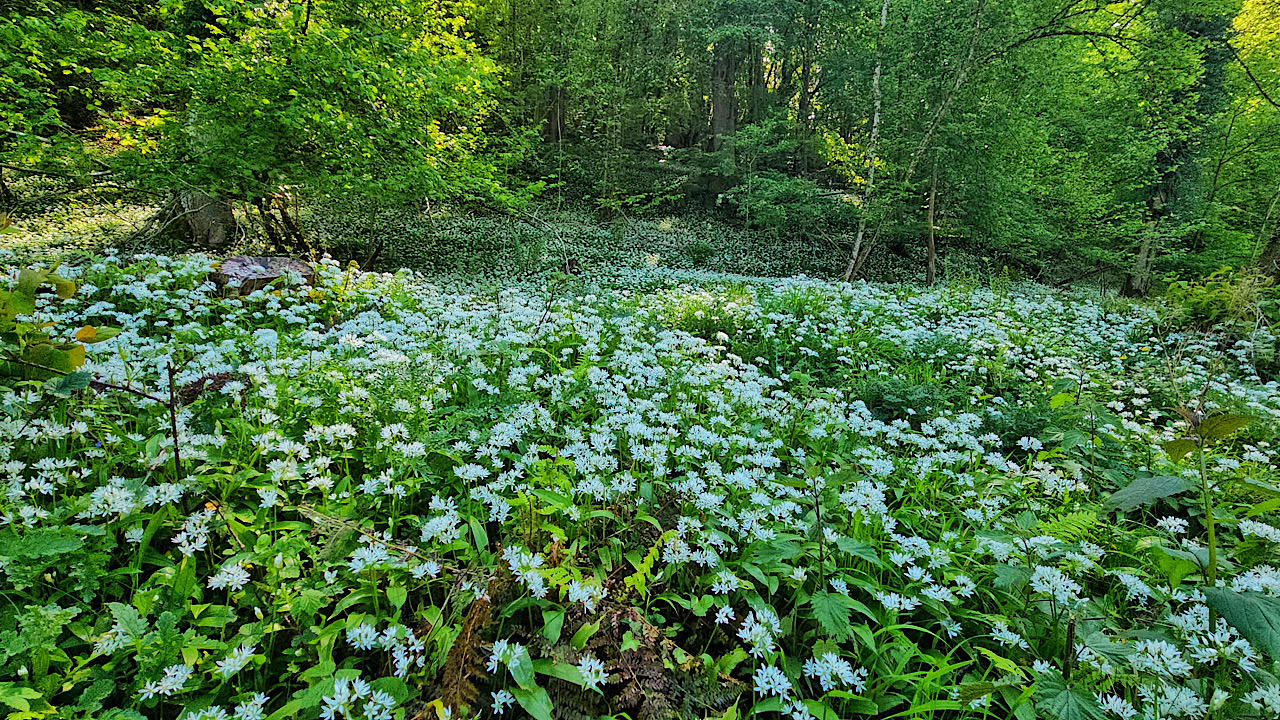Have you ever tried wild garlic Pesto? If not, then you must read on. This is the best foraging Springtime recipe, that you can make, both cheaply and easily. And, when frozen this will last you throughout the year. With Mother Nature’s larder, wild garlic from the woodlands of the UK and Europe will provide you with the most delicious recipe ever.

I was first introduced to the idea of foraging when we lived in the Isle of Man. The island is awash with foraging opportunities and springtime is one of the best seasons, in my humble opinion. One particular plant I used to wait for eagerly, was the springtime wild garlic that covered the banks of our river valley. We lived in the forest and during April and early May, the area burst into life with these delicate little plants. A drive along the valley would always welcome you with the faintest hint of garlic filling the air. Then you knew spring had sprung. Whilst not the same as the garlic bulbs we buy from the supermarket, this bulbous perennial cousin offers a more delicate flavour.
I remember the time I picked my first bunch of leaves and took them back to my kitchen. The aroma was just so beautiful and then there was the taste. Wow, what a treat for the taste buds. Whizzed up with a handful of ingredients, it is such a gorgeous addition to recipes that I love to cook. I adore that nature provides us with this magnificent abundance.

Where and when to forage for wild garlic
Also known as ramsons, wild garlic just loves damp woodland and grows profusely in forests and alongside shaded streams and river banks. It is one of the symbols of springtime and foragers love this time of year. Until recently, using this little cutie has been reserved for hard core foragers and seasonal chefs, although these days it has become an easy to spot and popular plant for people to take into their kitchens.
Whilst the seedlings can be seen poking through the ground in February after their winter slumber, it isn’t until April that wild garlic is ready for picking. It flourishes in our woodlands until mid-May when it starts to go to seed, giving us one of the longest picking seasons. And the best bit about this plant, is its voracious growth. One small area of wild garlic in one season will have multiplied by the following year. So, whilst we mustn’t be greedy, springtime foraging for wild garlic really doesn’t have a huge impact on its sustainability. However, we must still be respectful of how much we collect.
When choosing the plants to harvest, avoid those at the front of the path, as they will be dirtier and of course risk having dog wee on them. I tend to go for plants hidden a couple of feet behind the path. Look for the smaller, more delicate leaves, rather than the big ones, as they are older and will have less taste. Pick a few flowers as well. They can be mixed in perfectly, or used as decoration for salads. You can even eat these on their own, raw. You only need a small amount of flowers, in part because of their strong flavour, and perhaps more importantly, because they are the source of next year’s crop, so we must be mindful of that and be responsible foragers.

How to make wild garlic pesto
This is such an easy recipe and within 10 minutes you will have completed your foraging creation. All you need is a hand blender, some pots or Kilner jars and a few ingredients, which I have listed below.
- Two large handfuls of young wild garlic leaves, and a few flower clusters.
- 1/2 a wedge of Parmesan cheese grated (or cheaper equivalent)
- A good glug or two of Olive oil to give some moisture to the mix
- A handful of Pine nuts, or walnuts also work really well, and are a cheaper option
- Salt to taste (optional)
I don’t worry about measurements when it comes to making wild garlic pesto, as it is more about the taste. There is a slightly salty hint to the pesto thanks to the Parmesan, which is important. So, if you use another hard cheese, then you may need to add some salt.
Wipe your leaves rather than washing them and shake your flowers. You don’t want any unwanted protein from little bugs. Then place these in your bowl or hand blender attachment. Add your grated Parmesan, one glug of the oil and nuts and whiz for a few minutes. You don’t want the mix to be too wet, so add the oil in bit at a time. Give it a taste regularly and add more cheese or oil as necessary. You’re looking for a fluid consistency and earthy garlic taste. Then spoon it into a Kilner jar, glass pot, or a small plastic container that you can store in the freezer.
If you want to just store it in the fridge, then it will last a couple of weeks.

Ways to use wild garlic
Whilst I have profiled the pesto sauce, of course, there are many other ways you could use the plants. Here are some ideas, thanks to the Good Food website.
- The stalks of the plant can be used like chives
- The flowers used to decorate a salad
- The leaves used in combination with nettles to make a garlic nettle soup.
- Wilted leaves can be used like spinach
- The pesto can be used with pasta, stuffed in chicken breasts and wrapped in Parma ham or smothered over a salmon fillet.
- Why not make a garlic pesto butter by mixing a slab of butter with the pesto or simply blended leaves without the Parmesan?
There are so many options for this diverse plant that offers us a profuse and indulgent larder ingredient, courtesy of Mother Nature.
I would love to hear what you have done with your foraged springtime garlic. Drop a comment below to let us know your recipe ideas.
If you like this, then you might enjoy our Cook Book, which you can find in our Resource Library and is free to download. It has a whole host of recipes that we cook in our motorhome whilst on the road. Simply, tasty and healthy food, created with love. Happy eating.
/Karen


0 Comments